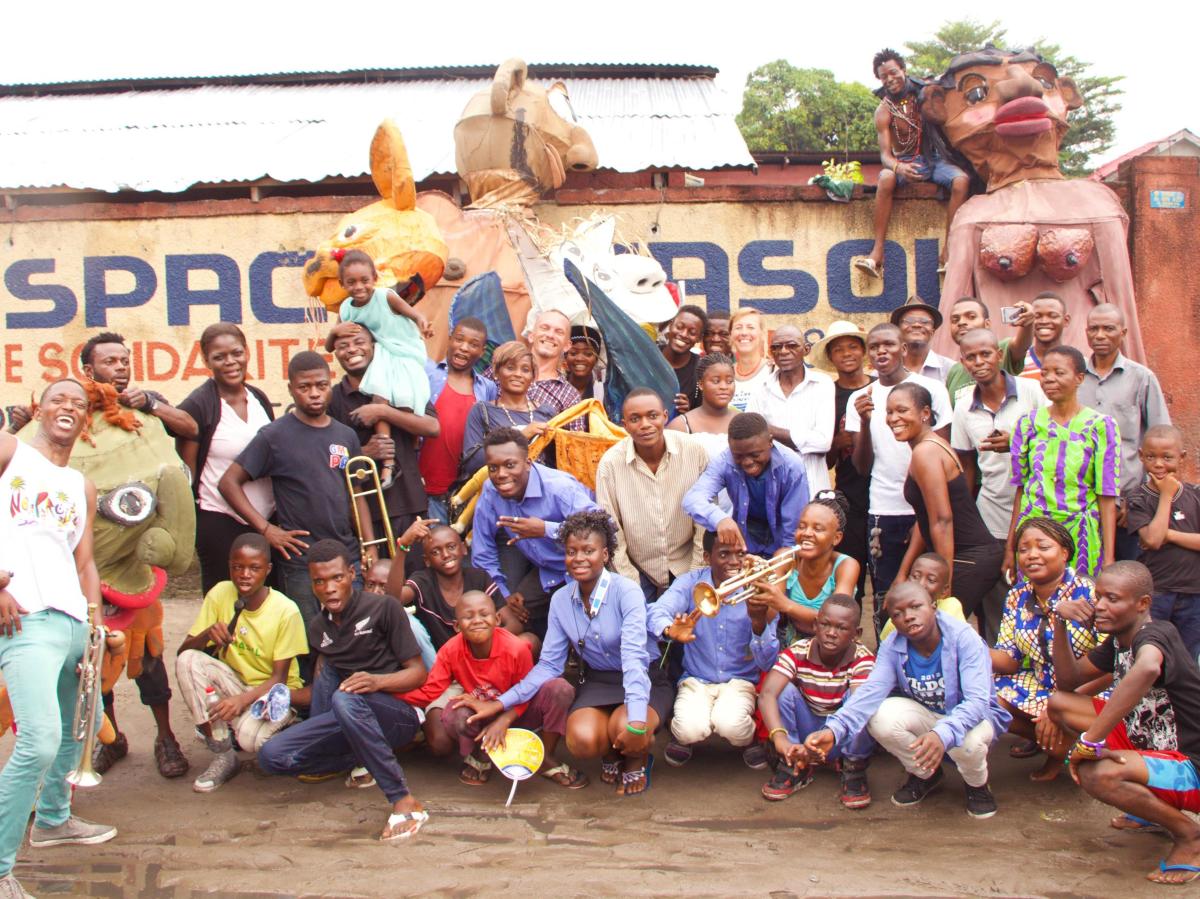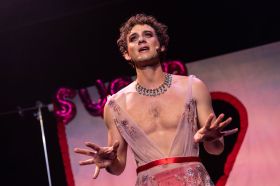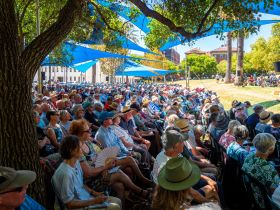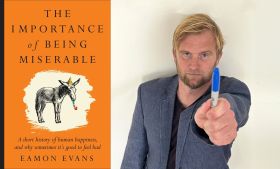Photo: People’s Puppet Project in Kinshasa. Supplied.
With the summer festival season in full flight across the pond, Australian artists and arts organisations are in hot demand.
Whether it’s tours, residencies, professional development opportunities or partnership projects, investing time, money and energy on overseas activity can pay dividends at home as well as abroad.
We speak to four arts organisations that have been making international waves to find out what “international engagement” really means, how to build the right international connections, and what else needs to be considered when developing and touring work overseas.
Partnering with the right organisation
It was a viral video that was the catalyst for a connection between giant puppet company Snuff Puppets, based in Melbourne’s western suburbs, and a cultural centre in Kinshasa, the capital and largest city in the Democratic Republic of the Congo.
When footage of Snuff Puppets’ Everybody performance outside the Melbourne Recital Centre went viral in 2015, artist Stefanie Oberhoff, who runs an international arts partnership program and works with Espace Masolo cultural centre, was watching on from Stuttgart.
Espace Masolo runs art and education programs for street children, orphans, ex-child soldiers and adults and had already started some smaller puppetry work. Facilitating a collaboration between the two organisations was an ideal outcome for everyone involved.
‘It really was right up our alley,’ said Snuff Puppets Producer, Katrina Chandra. ‘Snuff Puppets is about connecting globally at grass-roots levels between artists and non-artists to make a better world.’
In Kinshasa, the Snuff Puppets team worked with children and adults to teach them skills in designing and building puppets and in performance. While the collaboration was in new territory geographically, Snuff Puppets have collaborated with communities for nearly two decades through the People’s Puppet Project. The outcomes of these international workshops are a result of grass-roots community activities on local ground.
‘There are two really tangible outcomes: we provide a real self-esteem boost for people, and feelings of confidence and creative fulfilment. It makes a difference to how people live their lives,’ said Chandra.
‘Ultimately, we teach the people how to build the puppets, we teach them how to perform the puppets, and then they keep them and have an ongoing ability to work and generate money out of art.’
The Kinshasa collaboration resulted in a new work that has since toured Germany and the community in Kinshasa has already received a commission to build more giant puppets for a golf tournament in the Congo. In 2018, Snuff Puppets will return to Kinshasa for a second People’s Puppet Project, which will aim to bring even more business opportunities to the community.
When planning to work in a different cultural environment for the People’s Puppet Project, Snuff Puppets first develop a close partnership with people on the ground. ‘This research necessarily includes seeking out local community groups, often through local Councils. Our experienced artists have learned how to work with communities over many diverse projects and pass these skills on to new artists,’ said Chandra.
Her advice to arts organisations similarly invested in working with local communities is to be open-minded and willing to exchange culture. Art workers should also attempt to ‘learn as much as possible from the skills of experienced artists,’ she added.
Professional development
While international activities can be costly endeavours, organisations agree that the professional development opportunities they offer are priceless.
Melbourne’s Black Arm Band has a storied history of international tours but a central element of the company’s touring strategy is about more than just performances, it’s about embedding community outreach activities into its international itineraries.
Black Arm Band’s latest international project will see them tour Dirtsong to the USA and Canada and will include outreach activities with First Nations people in each destination.
‘That can be really rewarding and can be anything from workshops and panel discussions, right through to creative development opportunities for local artists,’ said Black Arm Band’s Executive Producer, Sarah Greentree.
International touring has similarly created opportunities for Circus Oz to build skills both outside the company as well as within it, said Circus Oz’s International Programming Manager, Teena Munn.
In addition to helping people the company wouldn’t ordinarily reach to build their skills, ‘outreach work also provides the company, creative personnel, performers and technicians exposure to different artistic influences, work practices and cultures, all of which can inform and influence their future work,’ Munn said.
For Black Arm Band, having someone working on the ground in a chosen destination ensures that rather than spend time trying to secure dates and venues, a company can channel their energies into programing.
‘Working with a local agent has been indispensable when it comes to accessing presenters. We have an American agent on the ground over there and she is invaluable on setting the tours up and getting the acts to the presenters over there, presenters that would be very difficult for us to have access to otherwise,’ said Greentree.
Cultural sensitivity and translation
One of the major benefits of international arts engagement is how it creates an ongoing conversation, which can continue long after you bump out.
‘Cultural diplomacy is becoming more and more crucial on the world stage, not only to promote Australian culture and our way of life to those we seek to engage with, but it also promotes a deeper understanding between countries,’ said Munn.
Circus Oz is a great Victorian success story. Having performed in 27 different countries, from the Edinburgh Fringe Festival to a refugee camp in the West Bank, they’ve translated parts of the show into languages including Hindi, Japanese and Danish.
The troupe has found their signature larrikin style has allowed them to talk about issues – such as the impact of consumerism and the benefits of cultural diversity – with a global audience.
When planning to tour work in a new cultural context, Circus Oz always researches the new market so the company can successfully adapt their work for the audience. Sometimes this adaptation is helped along by the close work of a good translator.
‘When touring to non-English speaking countries, we research the culture of where we are going to, and will then translate the text of the performance in the local language – for example, when we went to Brazil last year, we had quite a bit of the spoken elements translated which the local audience really appreciated,’ said Munn.
Circus Oz is currently working on the adaptation of the company’s newest work, Model Citizens, for a tour of China. Artistic Director Rob Tannion is working with a Chinese translator so the company can present the show in a cohesive and culturally sensitive way.
But new contexts don’t only mean overcoming language barriers. Hurdles can also arise around audience and presenters’ expectations. ‘As with most Circus Oz shows, there is usually one “cheeky” scene of a bare bottom and in our more conservative US cities we have adapted the show to be a little more clothed if requested,’ said Munn.
‘Quite often when we explain the context of the bare bottom as being a fun part of the narrative they prefer to go with it and most of the time are glad that they did!’
Overcoming misconceptions
Whether you’re part of a group show or you’re headlining a world tour, when Australian creatives take their work abroad they are representing more than just themselves: they are playing a role in helping to form a global view of Australian creativity and about Australian life more broadly.
Back to Back Theatre Executive Producer Alice Nash said the company’s many international tours have helped to open doors and counter misconceptions about Australia.
‘A company like Back to Back Theatre palpably projects Victoria and Australia as sophisticated, innovative, and dynamic. That does work to redress some of the misconceptions that Australia maybe isn’t culturally sophisticated, which it is,’ Nash says.
Back to Back, which works with an ensemble of performers with and without disability, not only changes minds about Australia’s creative output but also addresses issues of social marginality on a global stage.
‘We went to Buenos Aires last year and after talking to many, many people I realised that it had never even occurred to them that work of quality could be created by a group of artists like ours. So it can also have cultural shifts in a given artistic community or social environment that I would hope has a long term impact for those communities and people excluded from so called “normality” in a variety of places,’ said Nash
‘When Back to Back Theatre presents its work overseas, presenters and audiences become curious about the cultural, economic and social conditions that could produce such an unexpectedly virtuosic company of difference. I like to believe that this means they take a greater interest in what other artists have to say in Australia. This might prompt a person to visit, to look more closely or to program another Australian company of note.’
Think strategically
Once you have a work of calibre and are ready to take that to an international stage you have to develop a strong, but relevant, network. To do this, you need to think carefully about what context suits the work.
‘Some works are perfect for a large-scale theatre in an avant-garde international festival while others might sit with elegance in a remote regional venue that demands intimacy of scale and artist connection,’ said Nash.
‘Once you know who your audience is, you need to begin to gather information – speaking to people who know your work and where it could land, undertaking desk-based research and then taking a leap contacting people who seem to be the right ones, with the hope that you might develop an honest dialogue and working relationship for the future.
‘Make great work, think strategically and develop conversations with people who want great art in their communities.’
The impact back home
International engagement can transform an organisation, and its people, inside and out. It gives work a longer lifespan and a new audience base, it provides professional development and profile building for artists and organisations of all sizes.
‘I think of [international touring and engagement] as an investment in products that have been developed and should have a showing. The impacts of this are multifold. They relate to audiences, to public reception, and to economic dividends,’ said Nash.
But the benefits of this international engagement upon return run deeper than economics or professional gains. Work that is made in Australia often returns in a different form and can lead to new developments, explained Nash. ‘It’s a fluid, generative, rich process.’
The Inside Creative State Report is brought to you in partnership with Creative Victoria. Creative State is a Victorian Government strategy for growing Victoria’s creative industries across arts and culture, film and television, design, digital games, design and fashion. Enhancing international engagement is a key focus areas of the strategy.






